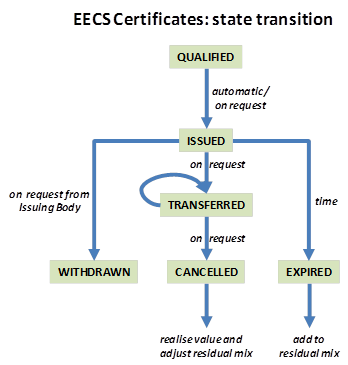Life cycle
The life cycle of an energy certificate is as follows:
1. Issue
For every fixed unit (this is default 1,000kWh - 1MWh, optionally 1Wh), a certificate is issued. This certificate takes the form of an electronic record. This certificate constitutes a transferable instrument that entitles to claim the environmental attributes of the represented energy.
2. Transfer
Once a certificate has been issued to an account in an electronic certificate registry, then its owner can transfer it to the account of another certificate holder by instructing the issuing body accordingly. The issuing body records the transfer of ownership in the registry, files any documentation relating to the transaction, and confirms to the seller to the transfer that it has taken place. The receiving issuing body notifies the buyer.

3. End of life The life of an EECS certificate can end in several ways:
a. Cancellation. EECS certificates are cancelled when they are "used" - this is normally at the point when the associated energy is consumed.
At any time during the life of a certificate, its owner can instruct the issuing body with whom it is registered to change its status to "untransferrable". Once a certificate has been cancelled in this way, it can no longer be transferred. Such an instruction is irrevocable.
Certificate owners may wish to cancel their certificates for a number of reasons. The most likely are where an energy supplier discloses to its customers the source of their energy; or where a large consumer does so to advertise its environmental credentials.
b. Expiry. A certificate can, and often is, expired after a certain period of time.
c. Withdrawal. An issuing body can withdraw a certificate from the registry where it has been issued in error, provided it has not been transferred to or from another account.
